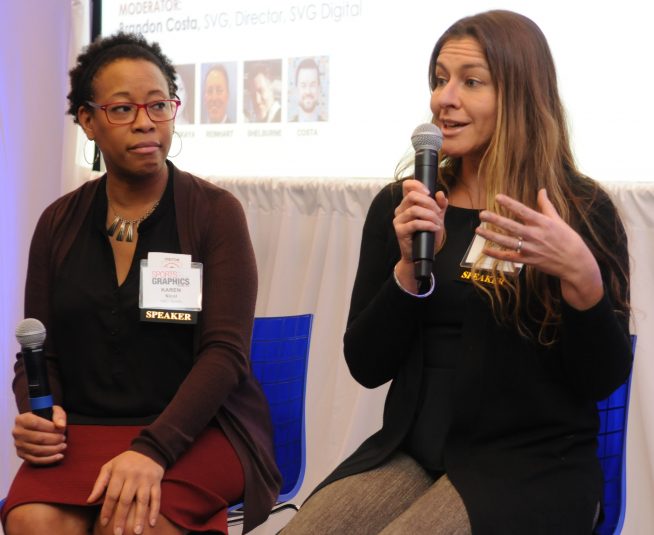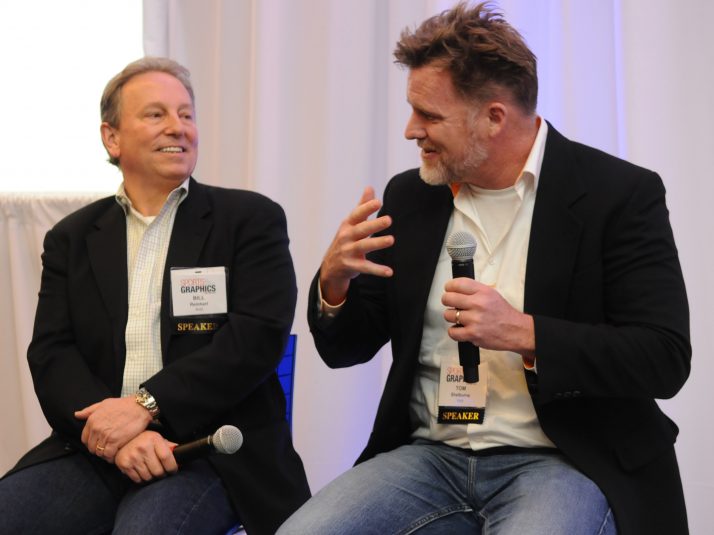Sports Graphics Forum: Small Screens Present Big Challenges for Mobile-Graphics Designers
Broadcast aesthetics don’t always work for other platforms
Story Highlights
Designing graphics for mobile devices may seem like a breeze — after all, a 4-in. cellphone screen is significantly less real estate than a 70-in. television — but, in reality, it presents a host of new challenges for designers used to a larger canvas. At SVG’s Sports Graphics Forum, held last week in New York City, digital-sports leaders from the client and vendor sides convened to discuss the brave new world of mobile graphics.
“There’s an aesthetic in broadcast that’s very refined and beautiful, with a lot of really fine details,” observed Maria Rapetskaya, founder/creative director, Undefined Creative. “A lot of designers tend to go small and pretty on the logos and the type, and, when those boards come back to me for mobile, I say bigger. And then I send it back one more time and say, No, I said bigger.”
The issue, she explained, is that broadcast-graphics designers are accustomed to working within constraints, such as title safety, that do not exist on mobile devices, and they try to include a level of fine detail that does not work on a smaller screen. But, she continued, designers need to find a way to translate the aesthetic from the big screen to the smaller in order to retain the brand.
“That’s kind of a big deal for designers who are used to working in broadcast only,” said Rapetskaya. “The problem that creates is, if you’re designing for both platforms and you need to adhere to a certain style guide, you need to be able to adapt the two so that enough of a look is translated into things that are going to be on mobile, things that are going to be compressed but still retain the aesthetic of your broadcast product.”
For Karen Nicol, creative director, digital products, NBC Sports and Olympics, the key is to keep in mind the specific platform for which you are designing. She shared her experiences of the 2016 Rio Olympic Games, for which she packaged an onslaught of OBS-produced feeds with the NBC Sports brand and delivered that mobile experience to millions of fans on a wide variety of devices.
“The biggest thing that we always try to never forget is that it’s always about the video. So we never lay anything over it,” she said. “We always try to figure out, number one, what’s our audience really looking for? Are they looking there to just view video, are they looking there to get more in-depth stats, do they want to have more of a second-screen experience?”
Nicol showed off her team’s unique approach to mobile devices, tablets, and desktops and how platforms with larger real estate lend themselves more to additional information, statistics and schedules, and enhanced interactivity.
“We try to build for the goal of the product,” she added. “The design never gets out of hand — it’s never about the design; the design is always there to enhance the product and the product goal — and then we always try to make sure that whatever we design can scale.”
In order to design graphics with a specific goal, scope, and scale in mind, clients rely on vendors like Vizrt and Avid to create tools that address the challenges of each individual mobile platform and enable graphics creation across those platforms.
“From the vendor side, we put the tools in the hands of our great customers, [and the software] gives them the flexibility that they need,” said Tom Shelburne, director, operations, Northern Region, Vizrt. “We, of course, like to provide best practices and guidelines, but, for the most part, they take it and elevate it to a whole other level that we didn’t really anticipate. We’re somewhat surprised when we see the great things that come out of it.”
Bill Reinhart, territory accounts manager, Avid concurred: “When you listen to the amount of work that they put into it, it’s really incumbent on the manufacturers to create the design tools that will reproduce that content the way it was originally intended. You can visualize things on any size monitor that you want, but you really need to have the tools that will allow that content to be accurately reproduced on the device that it is going to show up on.
“Mobile engagement is an ever evolving and fast-moving process,” he continued. “It’s up to the manufacturers to stay connected with the designers and understand what their challenges are so that we can deliver the tools that they need.”


